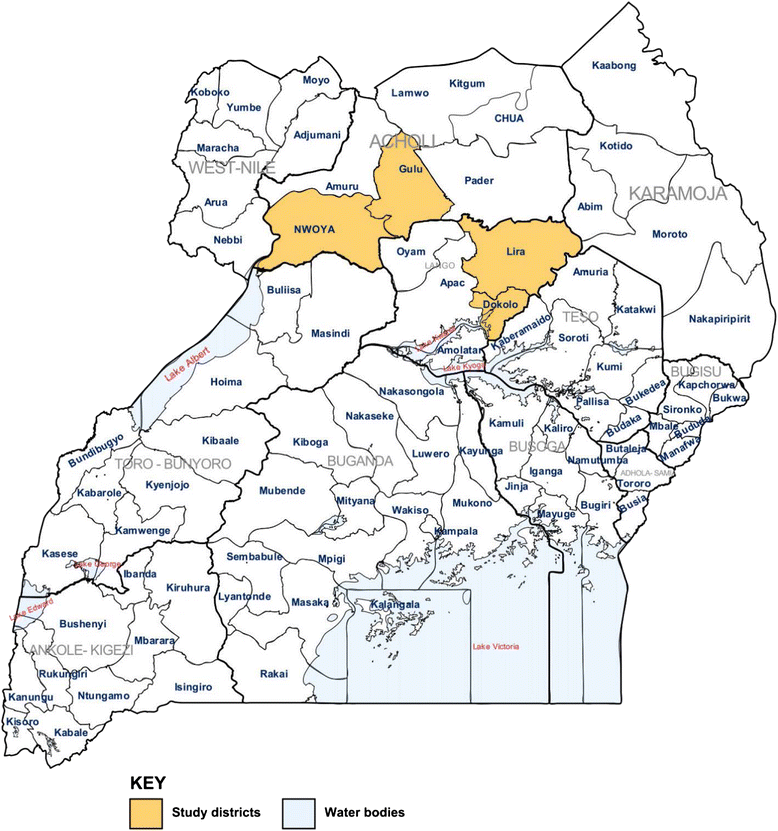Prevalence of K13-propeller gene polymorphisms among Plasmodium falciparum parasites isolated from adult symptomatic patients in northern Uganda
- PMID: 27543172
- PMCID: PMC4992308
- DOI: 10.1186/s12879-016-1777-7
Prevalence of K13-propeller gene polymorphisms among Plasmodium falciparum parasites isolated from adult symptomatic patients in northern Uganda
Abstract
Background: In the absence of an effective vaccine, malaria treatment and eradication is still a challenge in most endemic areas globally. This is especially the case with the current reported emergence of resistance to artemisinin agents in Southeast Asia. This study therefore explored the prevalence of K13-propeller gene polymorphisms among Plasmodium falciparum parasites in northern Uganda.
Methods: Adult patients (≥18 years) presenting to out-patients department of Lira and Gulu regional referral hospitals in northern Uganda were randomly recruited. Laboratory investigation for presence of plasmodium infection among patients was done using Plasmodium falciparum exclusive rapid diagnostic test, histidine rich protein-2 (HRP2) (Pf). Finger prick capillary blood from patients with a positive malaria test was spotted on a filter paper Whatman no. 903. The parasite DNA was extracted using chelex resin method and sequenced for mutations in K13-propeller gene using Sanger sequencing. PCR DNA sequence products were analyzed using in DNAsp 5.10.01software, data was further processed in Excel spreadsheet 2007.
Results: A total of 60 parasite DNA samples were sequenced. Polymorphisms in the K13-propeller gene were detected in four (4) of the 60 parasite DNA samples sequenced. A non-synonymous polymorphism at codon 533 previously detected in Cambodia was found in the parasite DNA samples analyzed. Polymorphisms at codon 522 (non-synonymous) and codon 509 (synonymous) were also found in the samples analyzed. The study found evidence of positive selection in the Plasmodium falciparum population in northern Uganda (Tajima's D = -1.83205; Fu and Li's D = -1.82458).
Conclusions: Polymorphism in the K13-propeller gene previously reported in Cambodia has been found in the Ugandan Plasmodium falciparum parasites. There is need for continuous surveillance for artemisinin resistance gene markers in the country.
Keywords: Artemisinin; Medicines; Northern Uganda; Resistance.
Figures
Similar articles
-
K13-propeller gene polymorphisms in Plasmodium falciparum parasite population in malaria affected countries: a systematic review of prevalence and risk factors.Malar J. 2019 Mar 7;18(1):60. doi: 10.1186/s12936-019-2701-6. Malar J. 2019. PMID: 30846002 Free PMC article.
-
No polymorphisms in K13-propeller gene associated with artemisinin resistance in Plasmodium falciparum isolated from Brazzaville, Republic of Congo.BMC Infect Dis. 2018 Oct 29;18(1):538. doi: 10.1186/s12879-018-3453-6. BMC Infect Dis. 2018. PMID: 30373565 Free PMC article.
-
Polymorphisms of the artemisinin resistant marker (K13) in Plasmodium falciparum parasite populations of Grande Comore Island 10 years after artemisinin combination therapy.Parasit Vectors. 2015 Dec 15;8:634. doi: 10.1186/s13071-015-1253-z. Parasit Vectors. 2015. PMID: 26667053 Free PMC article.
-
Novel Plasmodium falciparum k13 gene polymorphisms from Kisii County, Kenya during an era of artemisinin-based combination therapy deployment.Malar J. 2023 Mar 9;22(1):87. doi: 10.1186/s12936-023-04517-2. Malar J. 2023. PMID: 36894982 Free PMC article.
-
Updates on k13 mutant alleles for artemisinin resistance in Plasmodium falciparum.J Microbiol Immunol Infect. 2018 Apr;51(2):159-165. doi: 10.1016/j.jmii.2017.06.009. Epub 2017 Jun 29. J Microbiol Immunol Infect. 2018. PMID: 28711439 Review.
Cited by
-
Changes in the frequencies of Plasmodium falciparum dhps and dhfr drug-resistant mutations in children from Western Kenya from 2005 to 2018: the rise of Pfdhps S436H.Malar J. 2020 Oct 22;19(1):378. doi: 10.1186/s12936-020-03454-8. Malar J. 2020. PMID: 33092587 Free PMC article.
-
Plasmodium falciparum Kelch Propeller Polymorphisms in Clinical Isolates from Ghana from 2007 to 2016.Antimicrob Agents Chemother. 2019 Oct 22;63(11):e00802-19. doi: 10.1128/AAC.00802-19. Print 2019 Nov. Antimicrob Agents Chemother. 2019. PMID: 31427297 Free PMC article.
-
K13-propeller gene polymorphisms in Plasmodium falciparum parasite population in malaria affected countries: a systematic review of prevalence and risk factors.Malar J. 2019 Mar 7;18(1):60. doi: 10.1186/s12936-019-2701-6. Malar J. 2019. PMID: 30846002 Free PMC article.
-
Day 3 parasitemia and Plasmodium falciparum Kelch 13 mutations among uncomplicated malaria patients treated with artemether-lumefantrine in Adjumani district, Uganda.medRxiv [Preprint]. 2024 Apr 27:2024.04.26.24306433. doi: 10.1101/2024.04.26.24306433. medRxiv. 2024. Update in: PLoS One. 2024 Jun 5;19(6):e0305064. doi: 10.1371/journal.pone.0305064. PMID: 38712186 Free PMC article. Updated. Preprint.
-
Day 3 parasitemia and Plasmodium falciparum Kelch 13 mutations among uncomplicated malaria patients treated with artemether-lumefantrine in Adjumani district, Uganda.PLoS One. 2024 Jun 5;19(6):e0305064. doi: 10.1371/journal.pone.0305064. eCollection 2024. PLoS One. 2024. PMID: 38837973 Free PMC article.
References
-
- Yeka A, Gasasira A, Mpimbaza A, Achan J, Nankabirwa J, Nsobya S, Staedke SG, Donnelly MJ, Wabwire-Mangen F, Talisuna A, et al. Malaria in Uganda: challenges to control on the long road to elimination: I. Epidemiology and current control efforts. Acta Trop. 2012;121(3):184–195. doi: 10.1016/j.actatropica.2011.03.004. - DOI - PMC - PubMed
-
- World Health Organization . World malaria report 2013. Geneva: WHO; 2013.
-
- Okello PE, Van Bortel W, Byaruhanga AM, Correwyn A, Roelants P, Talisuna A, D’ Alessandro U, Coosemans M. Variation in malaria transmission intensity in seven sites throughout Uganda. Am J Trop Med Hyg. 2006;75(2):219–225. - PubMed
-
- White NJ. Delaying antimalarial drug resistance with combination therapy. Parasitology. 1999;41:301–308. - PubMed
MeSH terms
Substances
Grants and funding
LinkOut - more resources
Full Text Sources
Other Literature Sources
Research Materials


